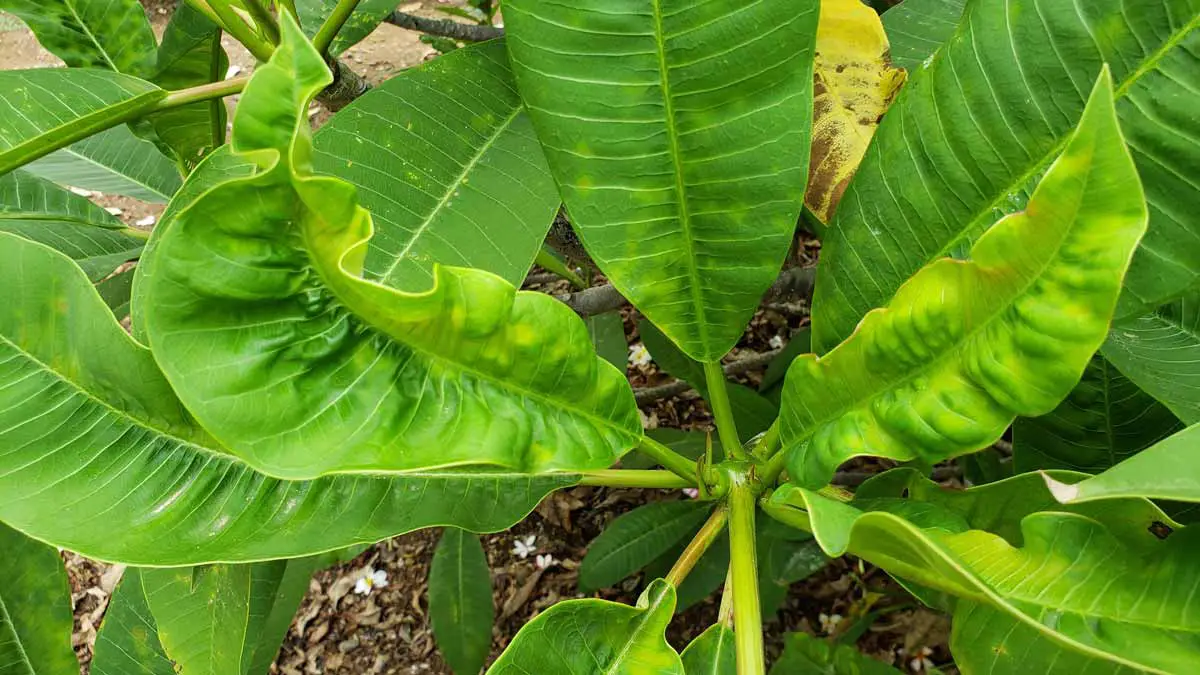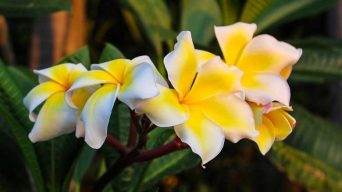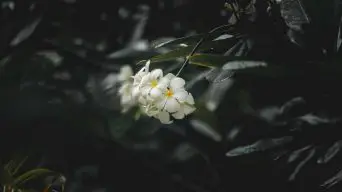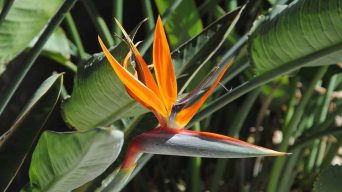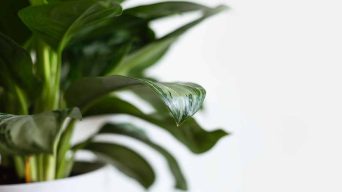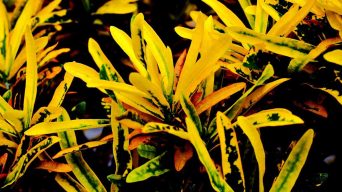Plumeria plants are native to tropical regions and are popular houseplants.
They are known for their fragrant flowers, which come in various colors.
This plant is easy to care for and can tolerate neglect.
However, plumeria plants can sometimes experience leaf curl.
This can be caused by several factors, including pests, lack of water, or temperature stress.
The first step in fixing the leaf curl is to identify the cause.
Once the cause is identified, you can take steps to fix the problem.
Why Are My Plumeria Leaves Curling and How Can You Fix It?
If you have noticed your Plumeria leaves curling, it could be caused by one of several reasons.
Each reason has a different solution, so it is essential to identify the problem before taking action.
Here are 10 possible causes of plumeria leaves curling and how to fix them:
1. Underwatering
Plumeria leaves typically curl when the plant is experiencing drought stress due to insufficient watering.
When Plumeria plants don’t receive enough water, the leaves will begin to droop and eventually curl to prevent further water loss.
While curling helps Plumeria leaves survive periods of drought, it harms the plant’s overall appearance.
Plumeria leaves repeatedly exposed to drought stress will become increasingly more susceptible to leaf curling and may eventually die.
How To Fix It
The best way to fix leaf curl caused by underwatering is to give your Plumeria plant more water.
Check the soil before watering, as it should be dry several inches down before you water again.
It is also essential to ensure that your Plumeria plant is in a pot with drainage holes, so the roots do not become waterlogged.
If the leaves are already curled, you can try misting them with water to help them uncurl.
2. Overwatering
Plumeria plants are tolerant of drought conditions, but they can be easily damaged by too much water.
When Plumeria plants are overwatered, the roots cannot properly absorb water and nutrients from the soil.
This causes the plant leaves to curl to prevent further water loss.
In some cases, Plumeria leaves may also turn yellow or brown and drop off the plant entirely.
How To Fix It
To fix an overwatered Plumeria plant, it is essential first to allow the soil to dry out completely.
Once the soil is dry, you can slowly start watering your Plumeria plant again, making sure not to overwater it.
It is also a good idea to check the drainage of your pot or planter to ensure that water can freely drain out.
If you find that your Plumeria plant is still not recovering, you may need to repot it into a well-draining potting mix.
3. Nutrient Deficiencies
Plumeria plants can also suffer from nutrient deficiencies, which can cause the leaves to curl.
The most common nutrient deficiency in Plumeria plants is a lack of nitrogen.
Nitrogen is an essential nutrient for Plumeria plants because it helps them produce chlorophyll, which is necessary for photosynthesis.
This can be caused by the plant not receiving enough nitrogen from the soil or the roots being unable to absorb nitrogen from the ground.
How To Fix It
If your Plumeria plant is suffering from nutrient deficiencies, you can try fertilizing it with a balanced fertilizer or a fertilizer high in nitrogen.
Plumeria plants must be fertilized every two to four weeks during the growing season.
It is also a good idea to have your soil tested to see if it is lacking in any nutrients.
Be careful not to overfertilize your Plumeria plant, which can also cause leaf curl.
4. Pests
Pests can also cause Plumeria leaves to curl.
The most common pests that affect Plumeria plants are aphids, scale insects, and mealybugs.
Aphids are small, soft-bodied insects that suck the sap out of Plumeria leaves.
This can cause the leaves to curl, turn yellow, and eventually drop off the plant.
Scale insects are small, hard-bodied insects that attach themselves to Plumeria leaves and stems.
They feed on the plant’s sap, which can cause the leaves to curl and turn yellow.
Mealybugs are small, soft-bodied insects that feed on the sap of Plumeria leaves.
This can cause the leaves to curl and turn yellow or brown.
A pest infestation can also cause a Plumeria plant to produce fewer flowers.
How To Fix It
To fix Plumeria curling leaves, start by checking for pests.
If you see any pests on the leaves, gently remove them with a cotton swab dipped in rubbing alcohol.
Once the pests have been removed, Plumeria curling leaves can be fixed by applying a diluted solution of neem oil or insecticidal soap to the affected area.
Apply the solution every few days until the Plumeria curling leaves have returned to their normal shape.
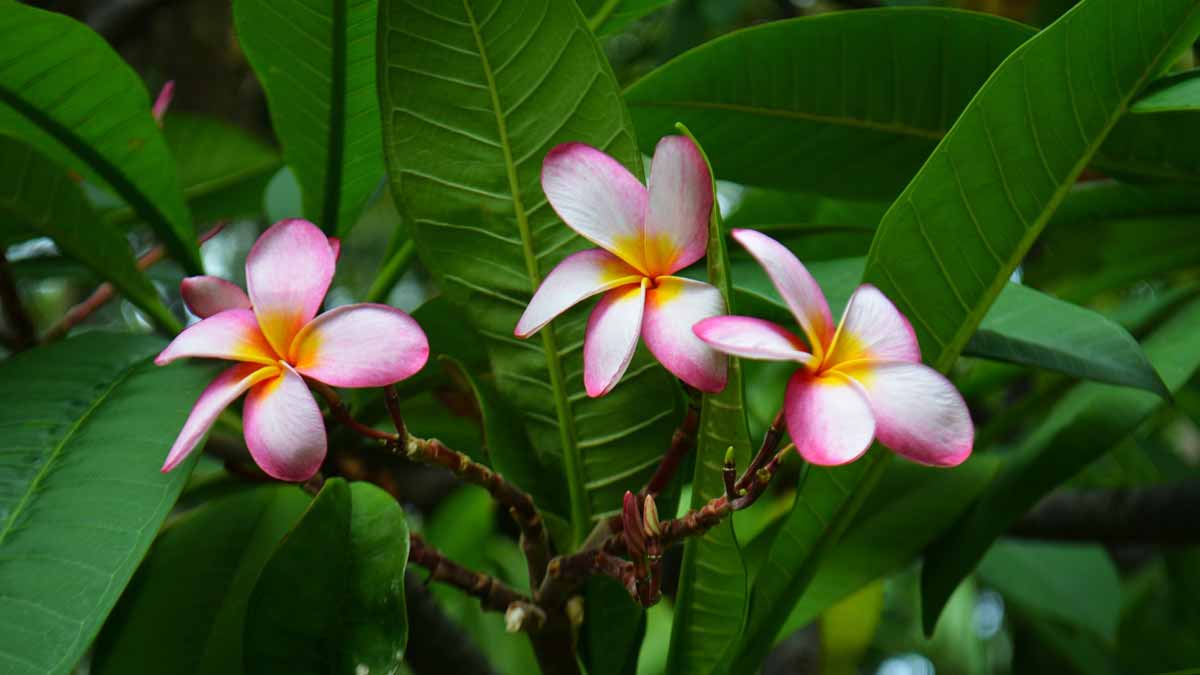
5. Heat Stress
Plumeria leaves typically curl when they experience heat stress.
This can be caused by several factors, including intense sunlight, high temperatures, and drought conditions.
When Plumeria leaves are exposed to excessive heat, the cells in the leaves begin to break down.
This causes the leaves to lose moisture and become dry and brittle. As the leaves lose water, they also begin to curl and deform.
In extreme cases, heat stress can cause Plumeria leaves to turn brown and drop off the plant.
While Plumeria plants are generally quite heat-tolerant, prolonged exposure to extreme heat can cause damage.
How To Fix It
If your Plumeria is suffering from heat stress, you can do a few things to help it recover.
- Make sure the plant is getting enough water. Plumeria requires moist soil, so water the plant regularly and mist the leaves if necessary.
- Move the plant to a cooler location. If possible, move the Plumeria to an area that receives filtered sunlight or afternoon shade.
- Increase humidity around the plant. Plumeria prefers high humidity, so mist the leaves regularly or place the pot on a tray of pebbles and water.
- Reduce the amount of fertilizer you’re applying. Too much fertilizer can stress Plumeria plants and make them more susceptible to heat damage.
- Protect the plant from extreme weather conditions. If possible, bring the Plumeria indoors or move it to a shady spot during excessive heat or cold periods.
Following these tips can help your Plumeria recover from heat stress and prevent future problems.
6. Too Much Sunlight
While Plumeria plants prefer full sun, too much sunlight can cause leaf curl.
When Plumeria leaves are exposed to intense sunlight, the cells in the leaves begin to break down.
This causes the leaves to lose moisture and become dry and brittle. As the leaves lose water, they also begin to curl and deform.
In extreme cases, too much sunlight can cause Plumeria leaves to turn brown and drop off the plant.
How To Fix It
Plumeria plants thrive in full sun, but if your plant shows signs of leaf curl, you can move it to a spot that receives filtered sunlight.
You can also try shading your Plumeria plant with a light cloth or umbrella during the hottest hours of the day.
If you live in an area with very hot summers, you may need to protect your Plumeria plant from the sun altogether.
You can do this by growing your Plumeria plant in a pot and moving it indoors during the year’s hottest months.
7. Soil Issues
The type of soil your Plumeria plant is grown in can also affect the health of the leaves.
Plumeria plants prefer well-drained, sandy soils. If the soil is too dense or clay-like, it can hold too much water and cause the roots to rot.
Dense soils can also prevent Plumeria plants from getting the oxygen they need to grow.
This can cause the leaves to curl and deform as the plant struggles to get the air it needs.
How To Fix It
If you think your Plumeria plant’s leaves are curling due to soil issues, you can do a few things to help.
First, make sure you’re using a well-draining potting mix. A mix of perlite and sand is ideal.
If the potting mix is too dense, you can add more perlite or sand to help improve drainage.
You can also try repotting your Plumeria plant in a pot with better drainage holes.
The roots of Plumeria plants need room to breathe, so make sure the pot you’re using is not too small.
8. Chemical Damage
The leaves of Plumeria plants are also susceptible to damage from chemicals.
Fertilizers, herbicides, and insecticides can cause leaf curl if they come into contact with the leaves.
Some chemicals are more harmful than others, but even a tiny amount of chemical exposure can cause leaf deformities.
Using too much fertilizer can also damage Plumeria leaves.
Fertilizers contain high levels of nutrients that can burn the leaves of Plumeria plants if applied in too high of a concentration.
How To Fix It
If you think your Plumeria plant’s leaves are curling due to chemical damage, you can do a few things to help.
- Flush the soil with water to remove any residual chemicals.
- Make sure you’re using the proper amount of fertilizer. Applying too much fertilizer can burn the leaves of Plumeria plants.
- Try to avoid getting any chemicals on the leaves of your Plumeria plant. If you must use herbicides or insecticides, apply them in the evening when the leaves are less likely to be damaged by the sun.
- If you think your Plumeria plant has been exposed to chemicals, try washing the leaves with a mild soap and water solution.
- Prune off any affected leaves and dispose of them properly.
9. Transplant Shock
Transplant shock occurs when a Plumeria is moved from one location to another, causing the roots to become stressed.
This stress can cause the Plumeria to lose leaves, and the remaining leaves may curl or discolor.
In some cases, Plumeria leaves may also drop off the plant entirely.
While transplant shock is usually temporary, it can sometimes cause permanent damage to the Plumeria.
How To Fix It
If you think your Plumeria plant is experiencing transplant shock, there are a few things you can do to help.
Make sure the Plumeria is getting enough water. The roots of the Plumeria need to be kept moist for the plant to recover from transplant shock.
You can also try lightly fertilizing the Plumeria. A light application of a balanced fertilizer will help the Plumeria recover from transplant shock.
Give the Plumeria time to adjust to its new location. Transplant shock can sometimes take weeks or even months to recover from.
10. Root Damage
Root damage is another common cause of Plumeria leaves curling.
Roots are responsible for taking in water and nutrients from the soil and delivering them to the rest of the plant.
If the roots are damaged, the Plumeria will not be able to get the water and nutrients it needs to survive.
This can cause the leaves to curl and deform as the plant struggles to get the air it needs.
Roots can get damaged by several things, including pests, disease, and poor drainage.
How To Fix It
If you think your Plumeria plant’s leaves are curling due to root damage, you can do a few things to help.
First, make sure the potting mix is well-draining. A mix of perlite, sand, and potting soil is ideal.
If the potting mix is too dense, you can add more perlite or sand to help improve drainage.
You can also try repotting your Plumeria plant in a pot with better drainage holes.
The roots of Plumeria plants need room to breathe, so make sure the pot you’re using is not too small.
Finally, make sure the Plumeria plant is getting enough water. The roots of Plumeria plants need to be kept moist to function correctly.
But, be careful not to overwater the plant. Too much water can also cause root damage.
Why Are My Plumeria Leaves Curling and Turning Yellow?
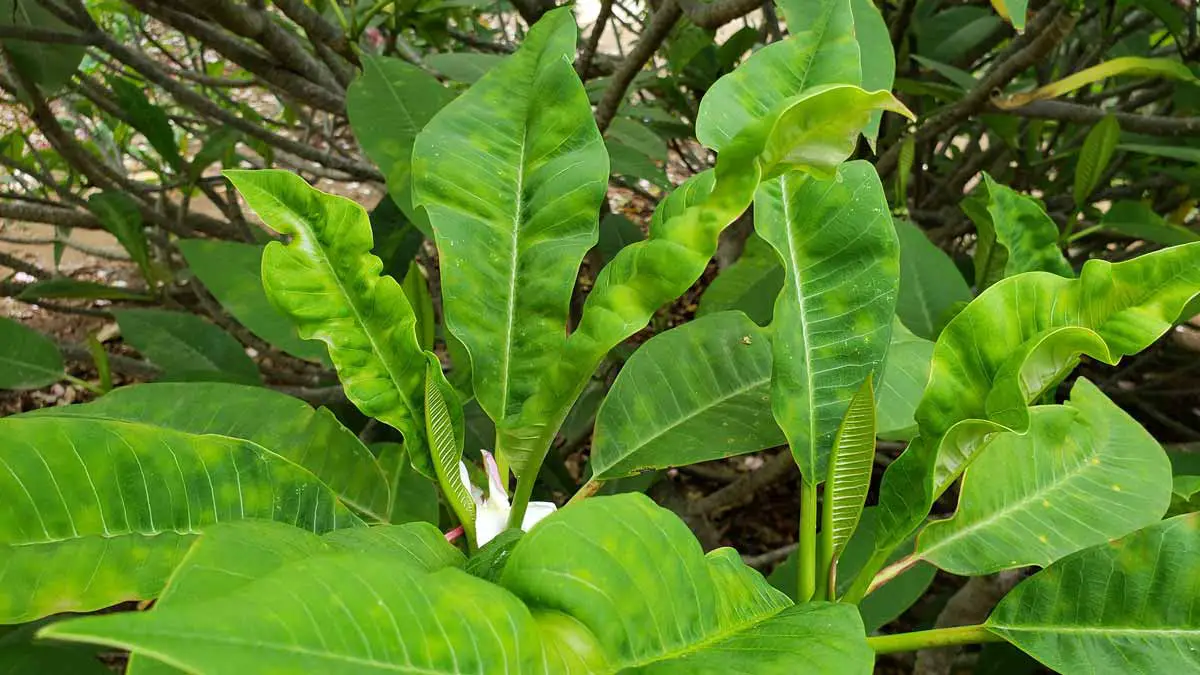
If your Plumeria leaves are curling and turning yellow, it could be a sign of overwatering.
When Plumeria plants are overwatered, the roots can’t get the oxygen they need and begin to suffocate.
This can cause the leaves to curl and turn yellow.
If you think your Plumeria plant is overwatered, the best thing to do is to let the soil dry out completely before watering again.
You should also ensure the pot has good drainage holes so the water can drain out easily.
If you’re still having trouble, you can try repotting your Plumeria plant in a pot with better drainage.
Why Are My Plumeria Leaves Curling and Turning Brown?
Plumeria leaves usually curl when the weather is too hot, when the plant is not getting enough water, or when it is not getting enough nutrients.
If the leaves are also turning brown, it could be a sign of Plumeria rust, a fungal disease that affects plants.
Plumeria rust usually starts as small yellow spots on the leaves, which eventually turn brown and can cause the leaves to curl and fall off.
If you think your Plumeria plant has Plumeria rust, it’s essential to take action immediately.
You can treat Plumeria rust using a fungicide according to the manufacturer’s instructions.
You should also ensure your Plumeria plant is getting enough water and nutrients and not being exposed to extreme temperatures.
Taking these steps can help your Plumeria plant thrive and prevent Plumeria rust from causing further damage.
Why Are My Plumeria Leaves Curling Down?
If your Plumeria leaves are curling down, it could be a sign of nutrient deficiency.
Plumeria plants need a variety of nutrients to grow healthy and strong.
If the soil lacks nutrients, it can cause the leaves to curl down and deform.
The best way to fix this problem is to fertilize your Plumeria plant with a high-quality fertilizer.
You can also try adding compost or other organic matter to the soil to help improve its nutrient content.
Why Are My Plumeria Leaves Curling Up?
If your Plumeria leaves are curling up, it could be a sign of too much light or heat.
Plumeria plants need a lot of light to thrive, but too much direct sunlight can cause the leaves to curl up.
If the temperature is too hot, it can also cause the leaves to curl up as the plant tries to protect itself from the heat.
The best way to fix this problem is to move your Plumeria plant to a location with more shade or cooler temperatures.
You can also try using a sheer curtain or other light-blocking material to filter out some of the light.
How To Prevent Plumeria Leaves From Curling
You can do a few things to prevent Plumeria leaves from curling.
- Make sure the Plumeria is getting enough water. The roots of Plumeria plants need to be kept moist for the plant to grow properly.
- Make sure you’re using the proper amount of fertilizer. Applying too much fertilizer can burn the leaves of Plumeria plants.
- Try to avoid getting any chemicals on the leaves of your Plumeria plant. If you must use herbicides or insecticides, apply them in the evening when the leaves are less likely to be damaged by the sun.
- Make sure the potting mix is well-draining. A mix of perlite, sand, and potting soil is ideal.
- If the potting mix is too dense, you can add more perlite or sand to help improve drainage.
- Make sure the Plumeria plant is getting enough light. Plumeria plants need at least six hours of direct sunlight each day.
- Protect your plant from too much sunlight by placing it in a spot where it will get some afternoon shade.
- Protect your Plumeria plant from cold temperatures. Plumeria plants are tropical plants and can’t tolerate temperatures below 50 degrees Fahrenheit.
- Protect your plant from extreme heat by placing it in a spot where it will get some afternoon shade.
- Avoid placing the Plumeria plant in an area where it will be exposed to drafts from doors or windows.
- Be sure to check for pests and diseases regularly. Plumeria plants are susceptible to several pests and diseases, so it’s crucial to catch them early.
- If you see any pests or diseases on your Plumeria plant, treat them immediately.
With proper care, you can prevent Plumeria leaves from curling.
By keeping the roots moist, using the proper amount of fertilizer, and protecting your indoor plant from too much sun or cold, you can keep your Plumeria healthy and happy.
Final Thoughts
Plumeria leaves curling can be caused by various issues, including nutrient deficiencies, pests, or lack of water.
The good news is that most of these problems are relatively easy to fix.
By following the tips in this article, you should be able to get your Plumeria back to health in no time!

